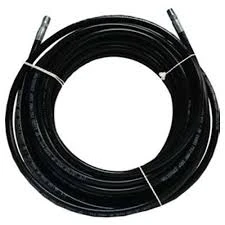brake hose sae j1401
Understanding Brake Hose SAE J1401 Importance and Key Specifications
The brake system is a critical component of any vehicle, ensuring safety and control while driving. Among the various parts of this intricate system, the brake hose plays a vital role in transmitting hydraulic pressure from the master cylinder to the brake calipers or wheel cylinders. One of the recognized standards for the manufacturing and performance of brake hoses is SAE J1401. This standard ensures that the hoses meet specific requirements for safety, performance, and durability.
What is SAE J1401?
SAE J1401 is a specification established by the Society of Automotive Engineers (SAE) that outlines the performance requirements for brake hoses used in automotive vehicles. This standard is crucial for both manufacturers and consumers, as it defines the minimum requirements for the construction, performance, and testing of brake hoses. The goal is to ensure that these components can withstand the rigors of demanding driving conditions while maintaining the integrity and safety of the braking system.
Key Specifications of SAE J1401
1. Material Requirements SAE J1401 details the acceptable materials for brake hoses, which are typically made from rubber, thermoplastic, or a combination of both. These materials must be resistant to heat, abrasion, and various chemicals, including brake fluids, to prevent degradation over time.
2. Pressure Ratings The standard specifies the pressure ratings for brake hoses. Hoses must be capable of withstanding high pressures generated during braking without bursting or leaking. SAE J1401 typically categorizes hoses based on their maximum operating pressure, which must exceed the pressure generated by the braking system during operation.
3. Temperature Resistance Brake hoses undergo a range of temperatures due to the friction created during braking. The SAE J1401 standard mandates that the hoses must perform effectively within a specified temperature range, ensuring they remain functional in both cold and hot environments.
brake hose sae j1401

4. Durability and Aging Tests To guarantee long-term performance, hoses must undergo various durability tests, including aging tests that simulate prolonged exposure to environmental conditions. This includes testing for ozone resistance, which is critical to prevent cracks and ruptures in the hose material.
5. Flexibility and Bending Radius Brake hoses must maintain flexibility to accommodate the movement of the suspension system without kinking or bursting. SAE J1401 specifies the minimum bending radius for hoses to ensure they can withstand repeated flexing during vehicle operation without compromising structural integrity.
6. End Fittings The standard also addresses the design and construction of the end fittings of the hoses, which must provide a secure and leak-free connection to the brake system. This is crucial for preventing brake fluid leaks, which could lead to brake failure.
Importance of Compliance
Adhering to the SAE J1401 standard is essential for manufacturers aiming to produce reliable and safe brake hoses. Compliance not only ensures the safety of vehicles but also enhances the manufacturer's credibility and quality assurance. For consumers, choosing brake hoses that meet or exceed SAE J1401 standards is a critical step in maintaining vehicle safety and performance. It reduces the risk of brake system failures and enhances overall driving experience.
Conclusion
The SAE J1401 standard serves as a cornerstone in the automotive industry for ensuring the reliability and safety of brake hoses. With strict guidelines on materials, pressure ratings, temperature resistance, and other critical specifications, SAE J1401 helps manufacturers create products that withstand the challenges posed by diverse driving conditions. As vehicles continue to evolve with advanced technologies, the importance of adhering to established standards like SAE J1401 becomes increasingly apparent. For drivers, this translates to peace of mind, knowing their brake systems are equipped with high-quality, reliable components designed to keep them safe on the road. In a world where vehicle safety is paramount, understanding and leveraging the significance of standards like SAE J1401 is crucial for both manufacturers and consumers alike.
-
Ultimate Spiral Protection for Hoses & CablesNewsJun.26,2025
-
The Ultimate Quick-Connect Solutions for Every NeedNewsJun.26,2025
-
SAE J1401 Brake Hose: Reliable Choice for Safe BrakingNewsJun.26,2025
-
Reliable J2064 A/C Hoses for Real-World Cooling NeedsNewsJun.26,2025
-
Heavy-Duty Sewer Jetting Hoses Built to LastNewsJun.26,2025
-
Fix Power Steering Tube Leaks Fast – Durable & Affordable SolutionNewsJun.26,2025

